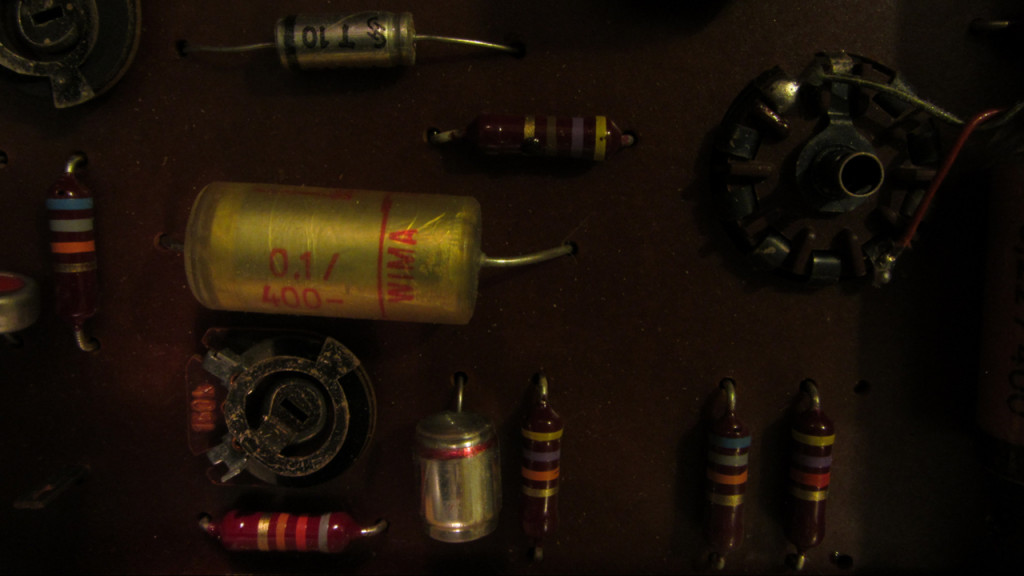Podcast Montages 01: Michael Penn’s Masters of Sex (2014)
Due to there being no current soundtrack album featuring Michael Penn’s music from Showtime’s Masters of Sex: Season 1, there are few score extracts in this particular podcast, although its focus is pretty much centered on the sounds of the Chamberlin / Mellotron instruments (both precursors to the concept and execution of sampling) and the Novachord – a huge keyboard-based instrument capable of emulating the sounds of an organ and orchestra instruments using a massive bank of tubes and circuits.
Because the podcast, archived on KQEK.com’s YouTube channel, mandates some visual backgrounds during the interview and short music extracts, I created visual materials from scratch.
The main background image is a snapshot of the bottom circuit board of an early sixties Grundig TK-46 reel-to-reel tape recorder, itself a behemoth machine that relied on several tubes and a Telefunken amplifier to record and playback 4 tracks.

Overlaid are shots of the same circuit board with spotlights on specific components. These shots were played from a Blu-ray player through my trusty Video Ventures Video Color Processor (model 7070). Because the contacts on the hue dial are dirty, it creates static and streaks when the knob is turned either way. These images were recorded onto SVHS, but played back on a VHS player because the incompatibility between the two formats results in a grainy, streaky image.


This ‘dirty’ footage was overlaid on top of the dimmed original circuit board shot in Adobe Premiere, and using a basic blur feature, the hot spots now hover and glow as the hue shifts from green to red to blue and back. You basically create analogue noise, record it onto an analogue format capable of handling hot levels, then play those back on a lesser format to enhance the noise before dumping it into the digital realm for fiddling.
As one of the historians featured in Dianna Dilworth’s 2008 documentary, Mellodrama: The Mellotoron Movie, states, the interest and use of R2R recorders began when servicemen brought back tape recorders from postwar Germany, so it’s no surprise established companies like Grundig (which still sort of exists) produced top-quality products designed, built, and exported from Germany to the rest of the world.
I won’t get into too many details about my recorder, except that it was gifted from a family friend more than 30 years ago, who probably dragged it from Germany or London to South Asia, and then Canada, where it sat in storage for years before it landed in my family’s hands. It still works, but barely, as it needs a top-to-bottom clean-up, new capacitors, probably replacement tubes, a new belt, and the restoration of some gears to re-enable the rewind feature.
All I’ll say is it manages to play tapes because of a blue rubber band you sometimes see banded around your mail. A fine piece of German engineering has been reduced to a contraption, but restoring this monster (and transporting its metal contents) is currently prohibitive.
I’m sure some audiophiles have some affection for this beast – if not for the sound or its sleek design and fat buttons and dials, then the ridiculously cool ‘magic eye’ tube which fires up when the unit’s turned on (a shot of the exposed tube is in the montage), and that distinct scent of old electronics warming up. (A number of videos featuring much cleaner / happier machines exist on YouTube.)
In any event, because the podcast centres on instruments using tubes, audio tape and quirky circuits, I yanked out my Grundig, shot a ridiculous amount of details of its exterior and playback features using my compact Canon SX-220HS camera, and cut together a montage in sync with Penn’s music, and hopefully as suggestive as the show’s Main Titles.
It actually wasn’t hard (er, sorry) to find male & female visual puns and metaphors, but it was tough whittling down and turfing shots until all that remained was 100% essential, and kind of followed Masters and Johnson’s Human sexual response cycle of Excitement, Plateau, Orgasmic, and Resolution phases for, uh, a recorder that really enjoys playing its media to a foggy conclusion.
For those interested in seeing the filthy montage in better HD, I’ve archived it on Vimeo with some podcast material to setup the montage’s tone:
The montage itself didn’t take long to render in 1080p, but the surrounding circuit board visuals bloated the file’s final render time to just under 3 hours. This is what happens when you’re insistent on sticking with analogue colours for more than 10 minutes in a podcast, even though it’s all just globs of red, green and blue.
Coming next: some details from the next podcast featuring macro footage of video gear in motion for my interview with Rewind This! director Josh Johnson.
Cheers,
Mark R. Hasan, Editor
Big Head Amusements

